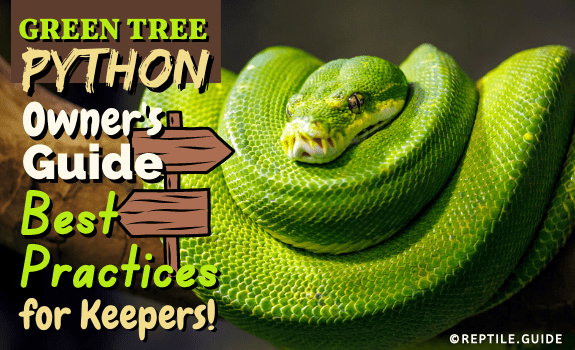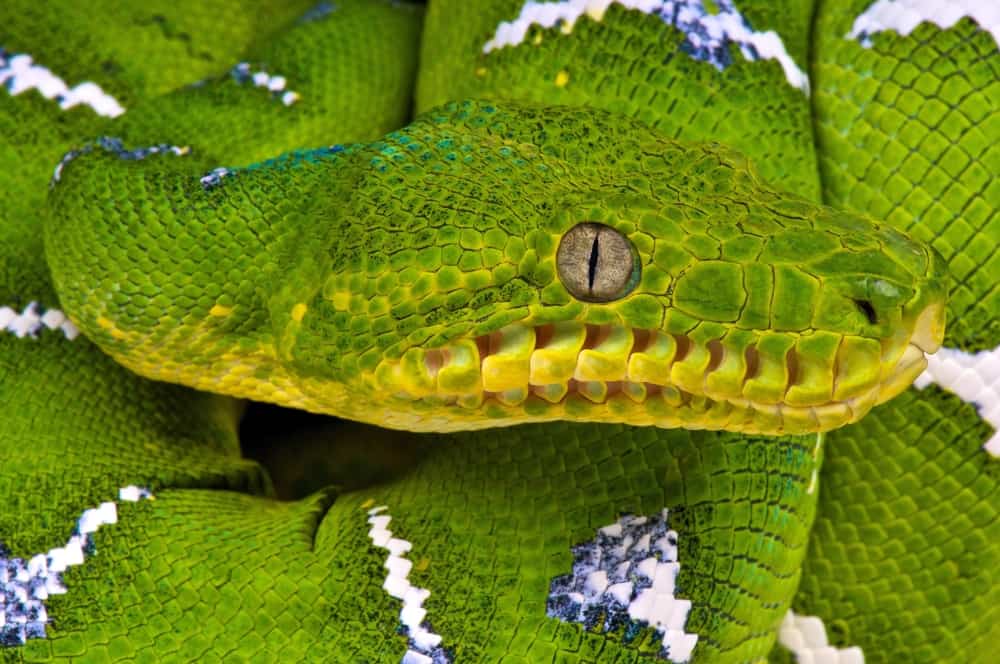The green tree python, Morelia viridis, is a species of nonvenomous snake. It has been growing in popularity in the pet trade because of its vibrant colors.
We don’t recommend green tree pythons as beginner snakes because of their more advanced care requirements.
If you have experience keeping snakes, continue reading to discover all you need to know about green tree python care.
You’ll learn about:
- Where to buy a green tree python
- How to feed your green tree python
- Potential green python health problems
- How to set up a green tree python enclosure
In This Article
Buying a Green Tree Python
Only buy captive-bred green tree pythons from reputable breeders.
The illegal pet trade is unethical and negatively impacts wild populations.
Wild-caught snakes are often dehydrated, covered in mites, injured, and malnourished. They’re traumatized from the process and are aggressive.
Snake farms in Indonesia sometimes pay locals to catch snakes from the wild illegally. They then pass the snakes off as captive-bred to legally export them.
Farm-bred snakes don’t always live in optimal conditions. Caretakers don’t have the best resources or knowledge of the correct husbandry practices.
Bushmaster Reptiles is currently the only trusted source of farm-bred green tree pythons in the United States.
Two credible brokers that deal with Bushmasters are Clockwork Reptile Company and Wall to Wall Reptiles.
The best sources of green tree pythons are private breeders. You can find them in online forums or at reptile shows.
Always ask the breeder for more information about the snake’s origins.
A few helpful questions when buying a green tree python:
- Does it eat regularly?
- What was the hatch date?
- Has it had any health issues?
- Can I see pictures of the parents?
- How long have you had this snake?
Legitimate breeders will be able to answer any questions you have about the snake’s history.
The snake you purchase should be eating reliably, at a healthy weight, parasite-free, and accustomed to handling.
Green Tree Python Price
The typical cost of a green tree python is between $500-$1,000.
Green tree python price varies depending on age and locality.
Adults are more expensive than juveniles. Breeders spend around a year raising them until they change to their permanent coloration as adults.
Adults don’t always turn bright green. Buying juveniles is cheaper because you won’t know what color variations it will have as an adult.
“Designer” morphs are the most expensive and easily go for over $1,000.
Wild-caught snakes are often cheaper, but paying extra for healthy captive-bred snakes is well worth the investment.
Green Tree Python Localities and Morphs
Green tree python color variations are called “localities.”
They have natural color variations based on geographic location. These traits are difficult to breed selectively.
Common green tree python localities include:
- Aru – Arus have short, bulky heads and blunt tails.
They typically have emerald green bodies with blue tones and clusters of white scales.
Juveniles are always yellow.
- Biak – These are the largest and most common green tree python locality.
Biaks can be more defensive than other localities. They have more elongated heads and pronounced nasal scales.
Biaks are typically varying shades of green with yellow, white, or blue patches. They can take up to five years to show their permanent colors.
- Sorong – Sorongs are light green with thin blue dorsal stripes.
They have long tails with blue or black tips.
- Jayapura – These are some of the smaller localities.
Jayapuras have dark green bodies with specks of white scales and a distinctive blue spine.
- Australian – One of the smaller localities.
They are bright green with white or yellow scales along the spine. Juveniles are always yellow.
- Manokwari – This locality is usually lighter shades of green with blue spots or stripes.
They have single white scales dispersed throughout their bodies and blue and black tails. Manokwaris have smaller heads and shorter snouts.
Green Tree Python Morphs
Breeders create morphs by selectively breeding snakes with specific color traits
They aren’t as common as localities, but breeders have created several color morphs.
Some of the most popular green tree python morphs:
- Calico – A genetic line of multi-colored green tree pythons.
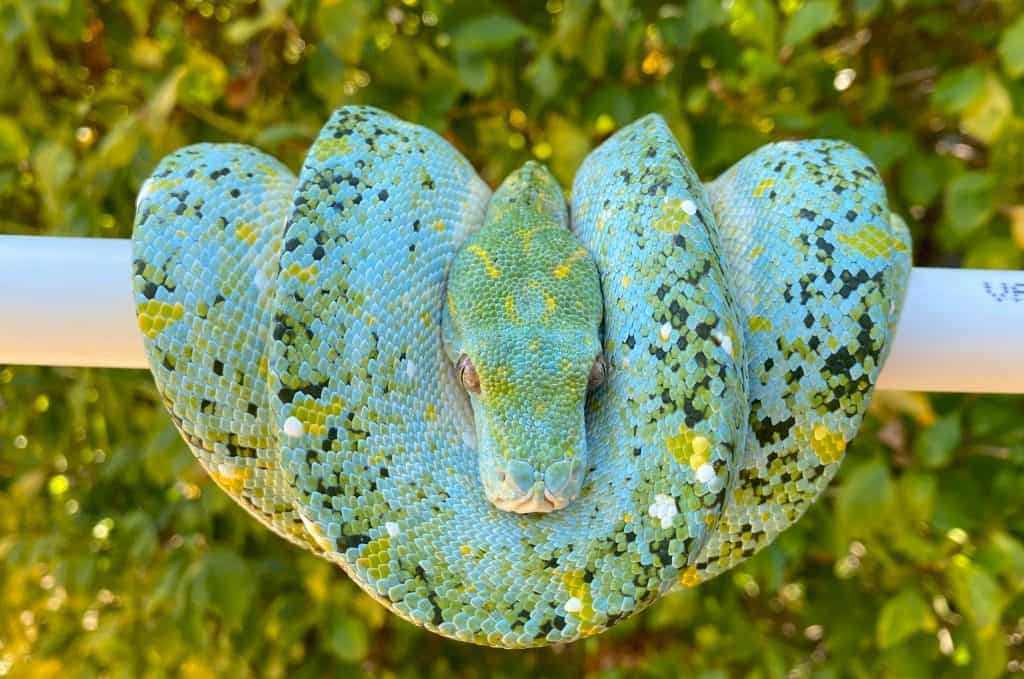
Image credit: u/TheChondroCompany (via Reddit.com)
- Albino – Albinism is a rare morph caused by a genetic defect. The lack of pigmentation makes them a light yellow color.
- High-blue – These snakes have varying shades of blue bodies with patches of green. Breeders typically create blue green tree pythons from Jayapuras and other snakes with a substantial amount of natural blue coloration.
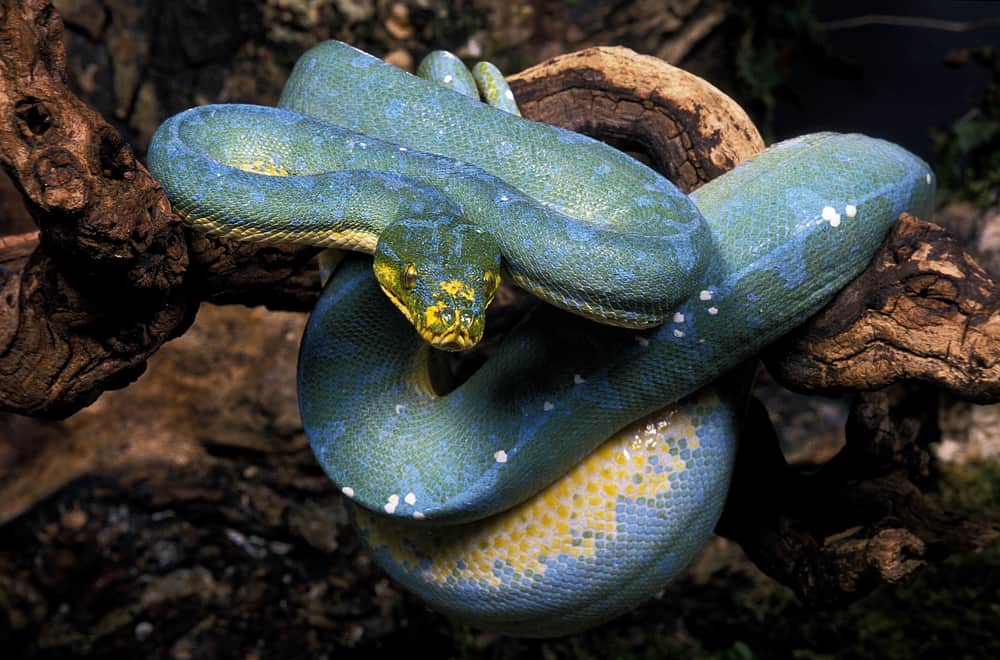
- High-yellow – These morphs are entirely or mainly yellow with green patches. They’re also called lemon-tree pythons.
Breeders typically use Biaks to create yellow green tree pythons.
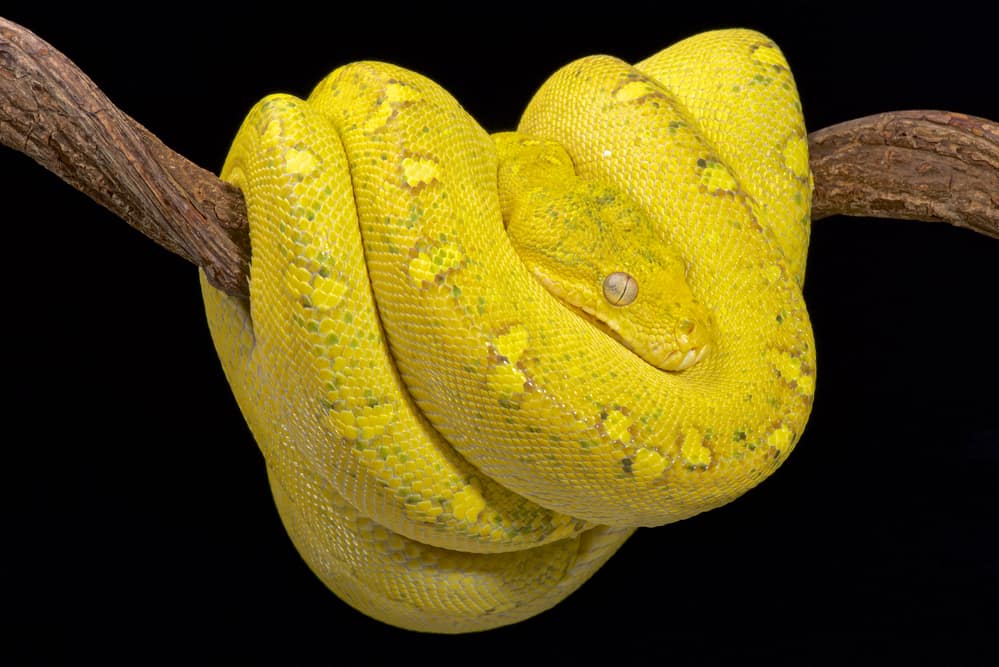
- Melanistic/High-black – This morph is also called “mite-phase.” They have black spots that resemble mites covering their bodies.
They come with varying amounts of black pigmentation. Melanistic morphs usually lose some of their black colorations as they age.
It’s a good idea to look at green tree python morphs in person before you buy one. It’s easy to alter an image to make the snake look more desirable.
Photoshopped blue or purple green tree pythons aren’t unheard of.
While some purple coloration is possible, a completely purple green tree python doesn’t exist.
Green Tree Python Enclosure
Setting up an appropriate green tree python enclosure is essential for their health and wellbeing.
Their enclosures should be as similar to their natural habitat as possible.
When planning your enclosure there are several key aspects to consider:
- Size
- Lighting
- Humidity
- Substrate
- Temperature
Type and Size of Enclosure
Traditional aquarium-style enclosures AREN’T suitable for green tree pythons.
The best enclosure for your green tree python is a vivarium with a front or side door.
This will make feeding, servicing, and handling your snake easier and less stressful than one with a top opening. It needs to be able to hold in heat and humidity.
Glass and plastic aren’t good insulators, but they’re waterproof and durable. Wooden cages retain heat and humidity better but also hold moisture.
They need a proper seal to avoid mold and rotting.
A lot of green tree python keepers prefer custom-built habitats constructed out of PVC or HDPE (High-Density Polyethylene).
Enclosures made out of these materials effectively hold in heat and humidity and come in any size you need.
Many people mistakenly think these arboreal snakes need tall enclosures.
They don’t need tall enclosures. The enclosure should be longer than it is tall to allow for a horizontal temperature gradient and propping.
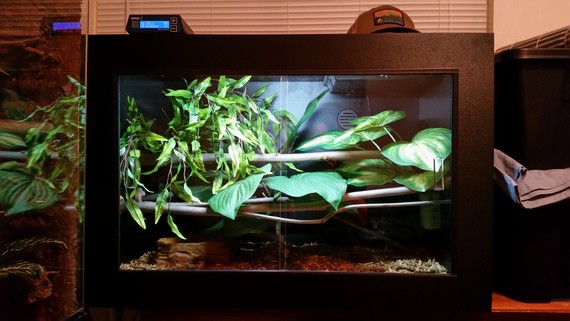
The size of your enclosure should vary with green tree python size.
Several popular sizing options for an adult green tree python:
- 24″x24″x24″
- 30″x24″x24″
- 36″x24″x24″
Start juveniles in smaller enclosures. An 18″x18″x12″ terrarium with the same setup as adults is suitable.
Many breeders and owners keep their young pythons in plastic tubs until they’re big enough for full-sized enclosures.
An enclosure that’s too big can be stressful. It can be difficult for babies to properly utilize the propping and temperature gradient.
Temperature
Your green tree python enclosure needs a temperature gradient between 78-88°F. Keep a cool side and a warm side with a basking area:
- Keep the basking spot around 88°F.
- The cool side should be around 78°F.
- An ideal temperature for the warm end is around 84°F.
You can use external heating pads and ceramic heat bulbs to maintain a warm side.
Heat sources with thermostats make it easier to keep your enclosure at the correct temperatures.
External heating pads will be more effective on the side of the tank rather than the bottom.
Your green tree python won’t be spending much time on the ground of the enclosure.
To avoid burns, make sure your snake can’t touch whatever heat sources you’re using.
Most green tree python keepers drop the enclosure’s temperature to 72°F at night.
This mimics their natural environment more, but it isn’t completely necessary.
Place thermometers on each end of the gradient. They will ideally read the air temperature on each side. Avoid placing them directly under lights and heat sources.
Humidity
The humidity level needs to be between 40-70%.
Humidity is one of the most important factors of keeping a healthy green tree python.
Their natural habitat is in tropical rain forests with high humidity.
There are a few ways to maintain a humid environment:
- Use a whole room humidifier.
- Add live plants to the enclosure.
- Install a misting system with a timer.
- Place a large water bowl at the bottom of the enclosure.
- Mist your snake’s enclosure once a day with a misting bottle. Some green tree python keepers mist their enclosures every 2-3 days.
You don’t need to soak the enclosure. It should dry out between each misting.
An environment that is too humid will lead to bacterial growth and diseases.
Place a hygrometer (humidity gauge) in the enclosure to monitor humidity levels.
Lighting
Green tree pythons don’t require special lighting.
Your snake doesn’t require full-spectrum lighting but it can bring out its colors. It also aids in plant growth if you choose to use live plants.
If you choose to use lighting, keep in mind that your green tree python needs 10-12 hours of darkness every night.
Be mindful of the light source emitting extra heat into your enclosure.
Hides and Decor
The most important pieces of furniture for your green tree python are sturdy perches.
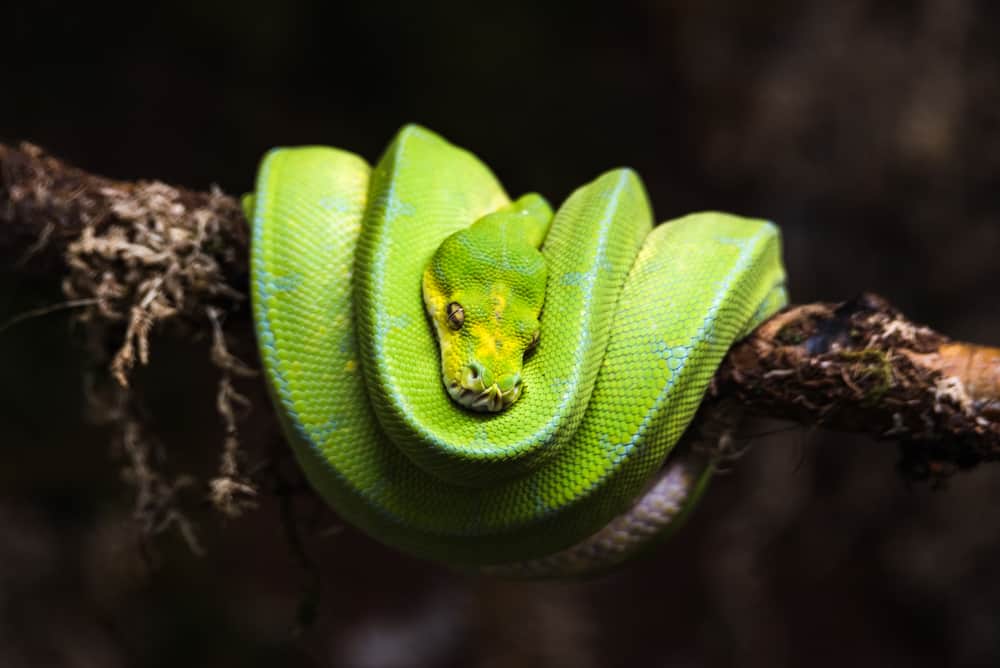
Perches should be as thick as the widest part of your snake’s body.
You can use bamboo, wood, PVC, or any other snake-safe material that is durable.
Securely attach at least two to three horizontal perches at different heights to give your snake options.
We recommend perches that are easy to remove for enclosure maintenance and handling your snake.
These snakes won’t use typical ground hides. The best way to create hiding areas is with live or silk plants.
Hanging plants create the best cover. Place hanging plants on both sides of the temperature gradient to make them feel comfortable in all areas of the enclosure.
A selection of reptile-safe live plants:
- Dracena
- Bromeliads
- Climbing Fig
- Philodendron
- Devil’s Ivy (Pothos)
Backgrounds, rocks, and other decor aren’t essential but can make the environment feel more natural.
Substrate
Substrate depends on keeper preference.
The most popular substrates include:
- Newspaper– Newspaper is cheap and easy to clean, but doesn’t help maintain a humid environment.
- Paper Towels – Paper towels are also cheap and easy to clean. They hold moisture better than newspaper.
- Cypress Mulch – Mulch is more natural than paper options and is absorbent without molding easily.
Substrates to avoid include:
- Pine
- Sand
- Cedar
- Aspen
Cleaning and Maintenance
A clean enclosure is essential for keeping your green tree python happy and healthy.
You should:
- Replace mulch monthly.
- Clean the water dish weekly.
- Change paper substrates weekly.
- Spot clean the enclosure and change the water daily.
- Do a full clean and disinfecting of your enclosure once a month.
You’ll need to move your green tree python to a safe location outside of its enclosure during a full clean.
This helps reduce stress and avoids exposing them to chemicals or fumes. You can use a 5-10% bleach solution or other sanitizers safe for reptiles.
Whatever you use, make sure there’s no smell lingering before you return your snake to its enclosure.
Steps of cleaning your green tree python enclosure:
- Turn off all lights and heating sources.
- Remove and disinfect all furniture.
- Remove old substrate.
- Sanitize and rinse the inside of the enclosure.
- Allow it to dry completely.
- Replace the substrate and furniture.
Green Tree Python Diet
Feed your green tree python a diet of frozen-thawed rodents.
Thaw the frozen prey in hot water and offer it while it’s still warm. This will help them detect the prey using their labial pits.
We don’t recommend live prey. Frozen prey is more convenient and you aren’t risking the live prey injuring your snake.
Use large forceps to avoid your snake mistaking your hand for food.
The prey item should be no larger than the widest part of your snake.
- Feed juveniles a small mouse once a week.
- Feed adults mice or rats every 12-14 days.
You may need to adjust the feeding schedule based on your snake’s individual needs.
It’s normal for them to undergo seasonal fasting, especially if they’re breeding.
Overfeeding is common for this species. An overfed green tree python can become overweight and lethargic.
This can lead to other health issues like heart disease and rectal prolapse. Avoid handling your green tree python the day before and after feeding to reduce stress.
Overfeeding and stress can cause your snake to regurgitate their meal.
Place a large water bowl on the bottom of the enclosure. It should be big enough for your snake to lay in.
Some keepers will place a bowl higher up, near perching. Green tree pythons are sometimes stubborn about coming down to the floor to drink.
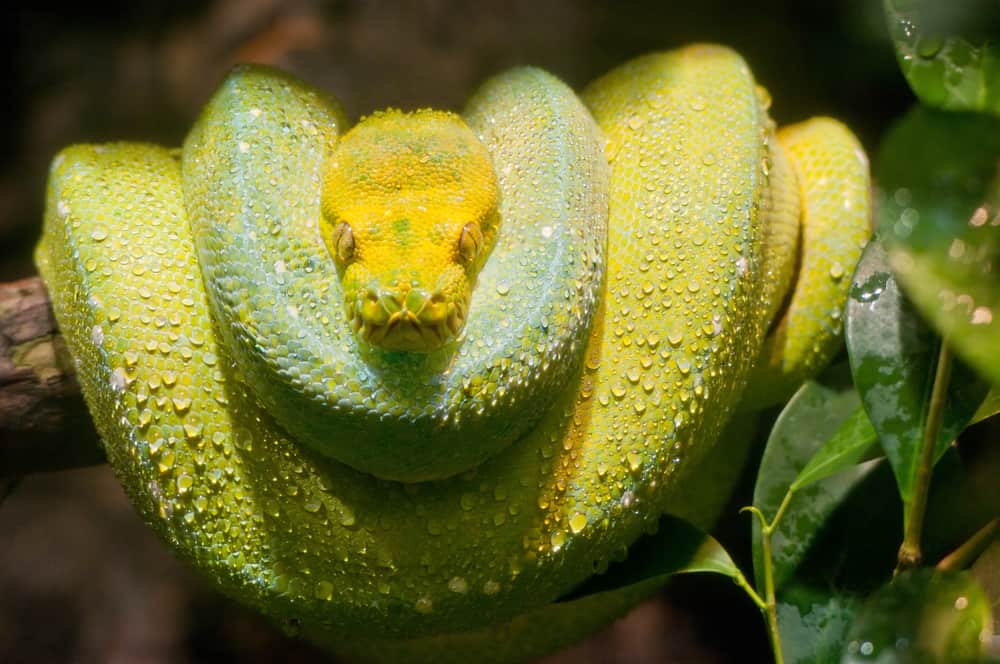
They’ll also drink water droplets from the furniture and walls of their enclosure after misting.
Handling a Green Tree Python
The best way to remove your green tree python from its enclosure is on a perch. We highly recommend installing removable perches when setting up your enclosure.
Move slowly and approach from below. Coming at your snake from above can trigger a defensive response.
Once you have them out of the enclosure, on their removable perch, offer your arm as a new perch. Don’t force them off of their perch, allow them to choose where they want to go.
Support their weight with both hands so they feel more secure.
Only handle them for short periods. This species has a reputation for being less tolerant of handling.
Handle them during the day when they’re less active and aren’t expecting a meal.
Be mindful of their tails while holding them. They have thin, delicate tails.
A consistent routine and proper handling methods will allow your snake to become accustomed to handling.
Green Tree Python Potential Health Problems
There are several health issues commonly seen in green tree pythons.
You can avoid most of these problems with good husbandry practices. It’s your responsibility to give your snake a healthy life.
Wild-caught green tree pythons are often kept in inadequate conditions and have poor health. This is one of many reasons to only buy captive-bred snakes.
Green tree pythons from reputable breeders are well cared for and in good health.
Always consult your veterinarian if you have concerns about your snake’s health.
Respiratory Problems
Respiratory infections are common in green tree pythons.
They’re usually bacterial infections but can also be viral, fungal, or parasitic.
Snakes get respiratory infections from:
- Stress
- Poor diet
- A dirty enclosure
- An environment that’s too hot and humid
The symptoms of respiratory infections in snakes progress slowly and often go unnoticed.
Symptoms include:
- Lethargy
- A raised head
- Bubbly mucus
- Loss of appetite
- Open-mouth breathing
A respiratory infection requires medical treatment.
Dehydration
Dehydration is common in green tree pythons.
It can lead to shedding problems and other serious health issues like kidney failure.
Make sure your snake’s water bowl is easily accessible. It should be directly under a perch.
A snake that’s stressed and uncomfortable in its environment might avoid coming down to drink out of a bowl.
The correct humidity levels and a misting routine will help avoid dehydration.
Symptoms of dehydration:
- Lethargy
- Constipation
- Sunken eyes
- Loss of appetite
- Wrinkles on skin
- Incomplete shed
Mouth Rot
Infectious Stomatitis, also known as mouth rot, is a bacterial infection. It’s caught while the immune system is weak.
Mouth injuries or poor husbandry practices like incorrect humidity levels or an improper diet lead to mouth rot.
Symptoms of mouth rot are:
- Loss of appetite
- Dead tissue in the mouth
- Red and inflamed mouth tissue
- Discharge from the mouth or nose
Snakes with mouth rot will need a course of antibiotics and may require surgery in more severe cases. It can spread to the lungs or digestive tract if left untreated.
Spinal Kinks
Captive green tree pythons are especially prone to spinal kinks. They’re rarely seen in wild green tree pythons.
They occur towards the end of the tail near the cloaca.
Spinal kinks aren’t well understood. It’s thought that they may be due to metabolic bone disease, a calcium deficiency disorder.
Some experts suspect the cause is osteomyelitis, an infection in the bone.
Another theory is that they’re a result of rough handling, particularly as juveniles. Kinks sometimes occur after sexing.
There may be several factors at play. Because of the uncertainty of its origins, there aren’t many preventative measures.
The best practice is to handle your snake carefully and make sure it’s healthy.
Water Blisters
Too much humidity and poor ventilation cause water blisters. They appear clear and feel soft.
They aren’t a serious health concern. You can leave the blisters alone to heal on their own after adjusting the humidity.
Tail Hanging
Experts believe tail hanging to be a symptom of several health issues.
A green tree python will hang its tail to thermoregulate when it’s too hot. Check the temperatures in your green tree python’s enclosure to ensure they’re not too high.
Tail hanging may also be a sign of lack of exercise. Give your snake several perching options and enough room to exercise in its enclosure.
Another possibility is that an accumulation of feces causes them to drop their tails from discomfort. In more serious cases, it can lead to rectal prolapse.
Wild Green Tree Pythons
The green tree python is native to tropical rainforests of Eastern Indonesia, Papua New Guinea, and the Cape York Peninsula of Australia.
They were once classified as Chondropython viridis. They were later placed in the Morelia genus after experts discovered their similarities with carpet vipers.
Green tree python enthusiasts frequently refer to them as “chondros”, a nickname derived from their old scientific name.
Adults reach an average of 4-6 feet. Females are typically larger than males.
They live an average of 15 years in the wild. With proper care, captive green tree pythons can live up to 20 years.
A baby green tree python is born bright yellow, red, or red-brown and permanently changes to green (or other variations) when they’re 6-24 months old.
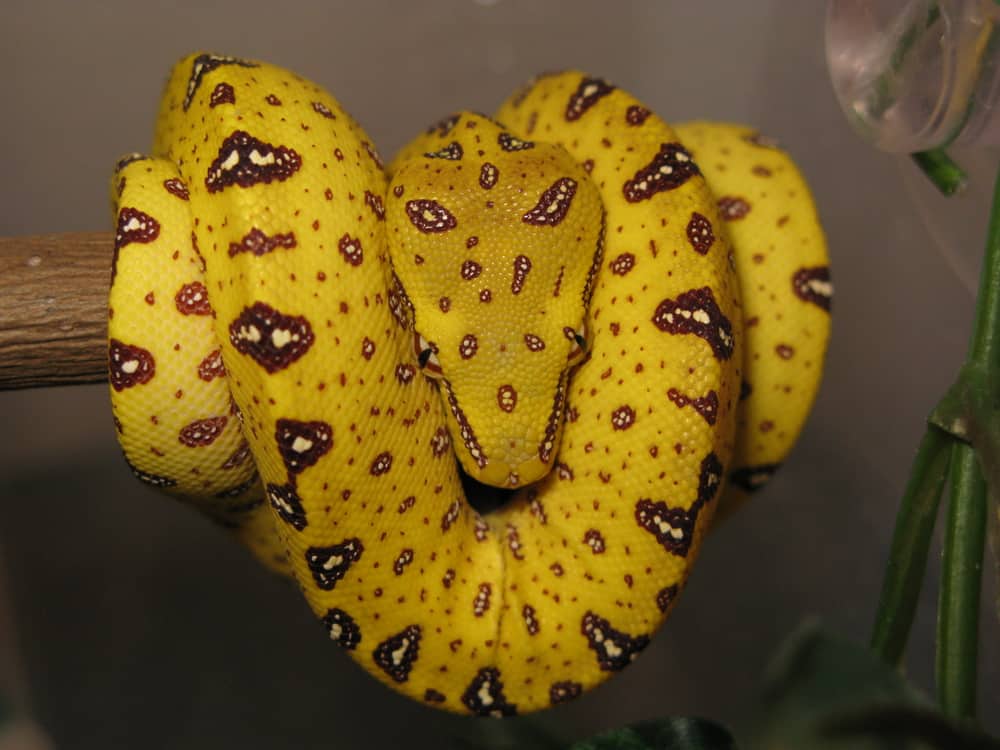
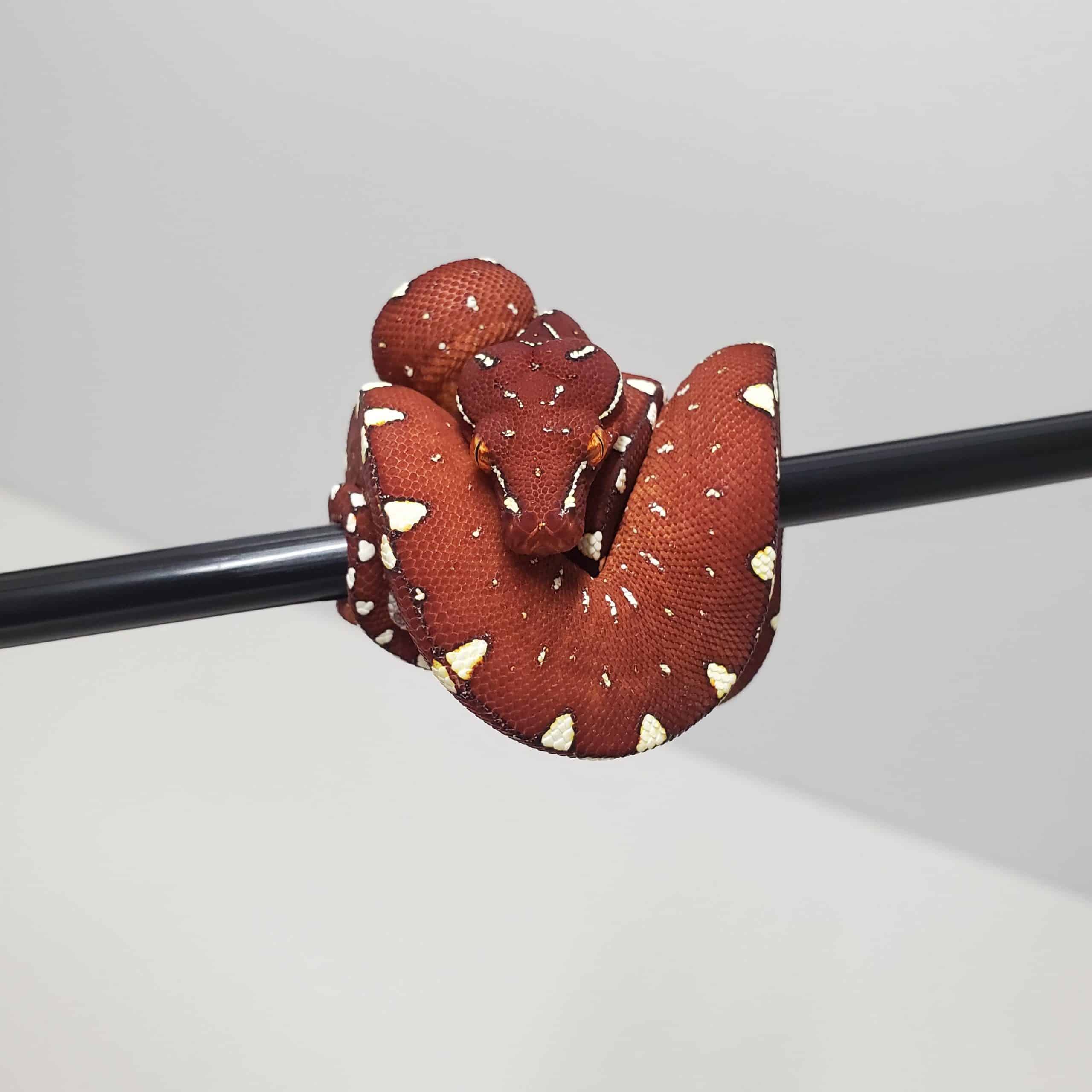
Image credit: u/VlClOUSLY (via Reddit.com)
This phenomenon is an ontogenetic color change.
This is an evolutionary adaptation to protect their young from predators. Juveniles are more terrestrial and blend in with the forest floor.
Adults spend more time in the trees and need to camouflage with the leaves.
They’re an arboreal species of python, meaning they spend most of their lives in trees.
They do something called caudal luring. The green tree python dangles its tail to draw prey in, then uses its prehensile tail to hold onto tree branches while they strike.
Green tree python teeth curve backward and dig in deep to hold onto prey.
They have over 100 long, curved teeth. Their bites are painful and can require medical attention.
Green tree pythons detect prey using their labial pits, or heat-sensing pits.
They’re diet generalists, but mainly eat mammals and small reptiles. Like other python species, they constrict their prey.
These snakes are nocturnal and do their hunting at night when they’re most active. Juveniles are more active during the day.
The green tree python is currently listed as least concern on the IUCN red list of threatened species.
Although their populations are stable, the illegal pet trade in Indonesia could lead to devastating effects if left unregulated.
Reproduction
Like other pythons, green tree pythons are oviparous, meaning they lay eggs.
The female typically lays 6-32 eggs per clutch in a hollow log.
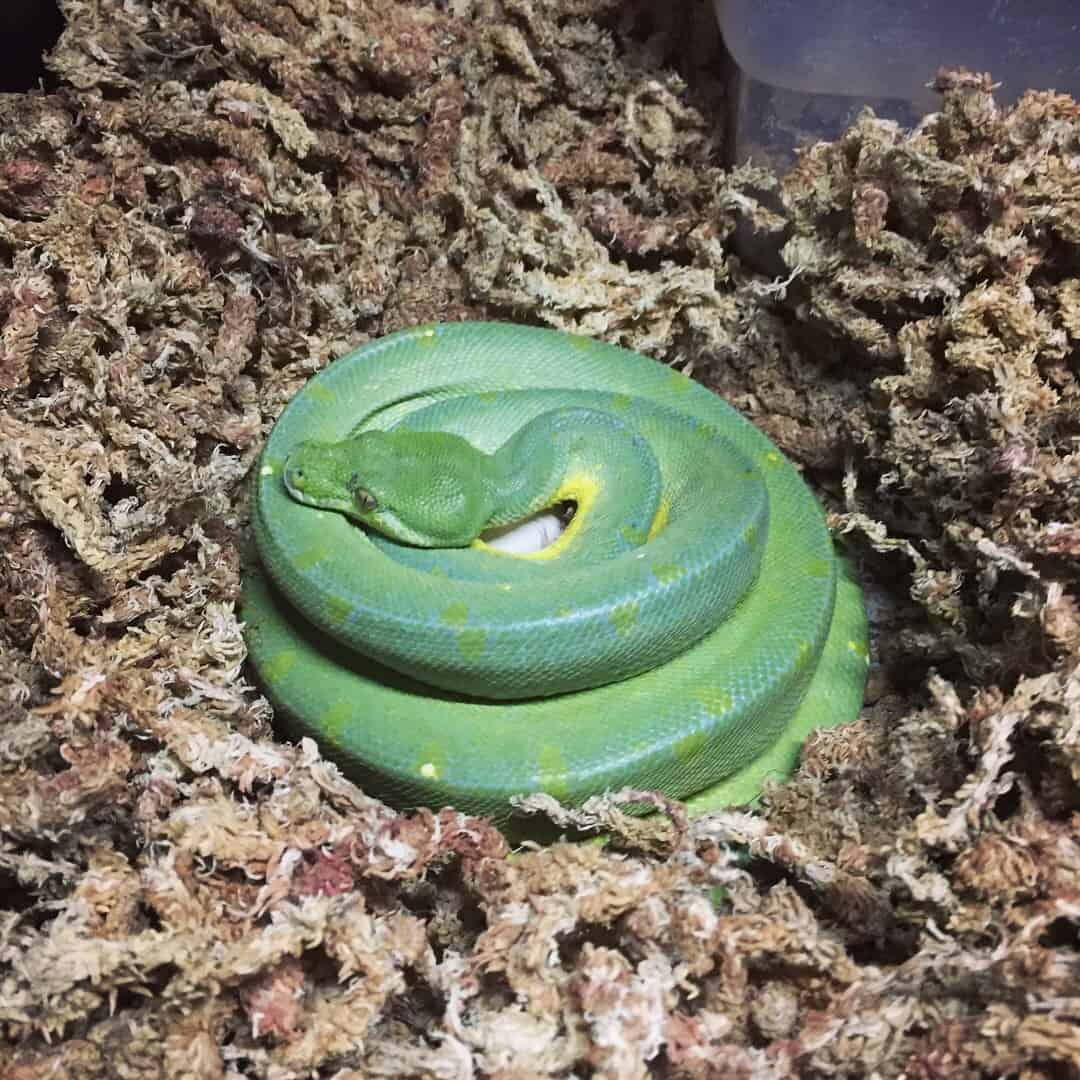
Image credit: u/gutermane (via Reddit.com)
Females go through a fasting period during this time. The eggs hatch after an average of 50 days incubation but can take 39-60 days.
Males reach sexual maturity after two years, while females are sexually mature around three years.
There’s little known about their breeding habits in the wild. Their behaviors in captive breeding programs suggest they have a seasonal breeding cycle, but not every year.
Are Green Tree Pythons Venomous?
Many people wonder: are green tree pythons venomous? The answer is no!
Green tree pythons are nonvenomous snakes.
All species of snakes from the family Pythonidae are nonvenomous. They kill their prey with constriction.
Do Green Tree Pythons Make Good Pets?
Green tree pythons make great pets for keepers with experience caring for snakes.
They have a bad reputation for being aggressive, but this isn’t always the case.
Wild-caught green tree pythons are aggressive.
Green tree python teeth are extremely long and sharp. Their bites are painful and sometimes require medical intervention.
You shouldn’t have problems with a captive-bred snake that is raised well and handled properly.
A reputable breeder will breed out aggressive traits. Some morphs, like the Biak, can be more aggressive than others.
Can Green Tree Pythons Live Together?
It’s best to keep green tree pythons housed singly unless you’re breeding them.
Green tree pythons can live together, but it probably isn’t worth it.
Keeping more than one together can create unnecessary stress. You risk the pythons fighting over space and food.
You need a considerably larger enclosure to successfully house green tree pythons together.
Emerald Tree Boa vs. Green Tree Python
People often confuse the emerald tree boa (Corallus caninus) and green tree python (Morelia viridis).
Convergent evolution has resulted in these two species having many similarities.
They both go through an ontogenetic color change, live in tropical rain forests, and have similar behaviors and hunting techniques.
Key differences between emerald tree boa vs green tree python:
- Size – Emerald tree boas are larger. They can reach lengths of six to nine feet, while green tree pythons average four to six feet.
- Location – Emerald tree boas live in South America. Green tree pythons live on the other side of the world in Indonesia, Papua New Guinea, and Australia.
- Head Shape – An emerald tree boa’s nostrils are more square. Their head scales are larger and labial pits are more distinct.
An emerald tree boa’s labial pits run along its upper and lower lips.
Green tree pythons only have one row of labial pits.
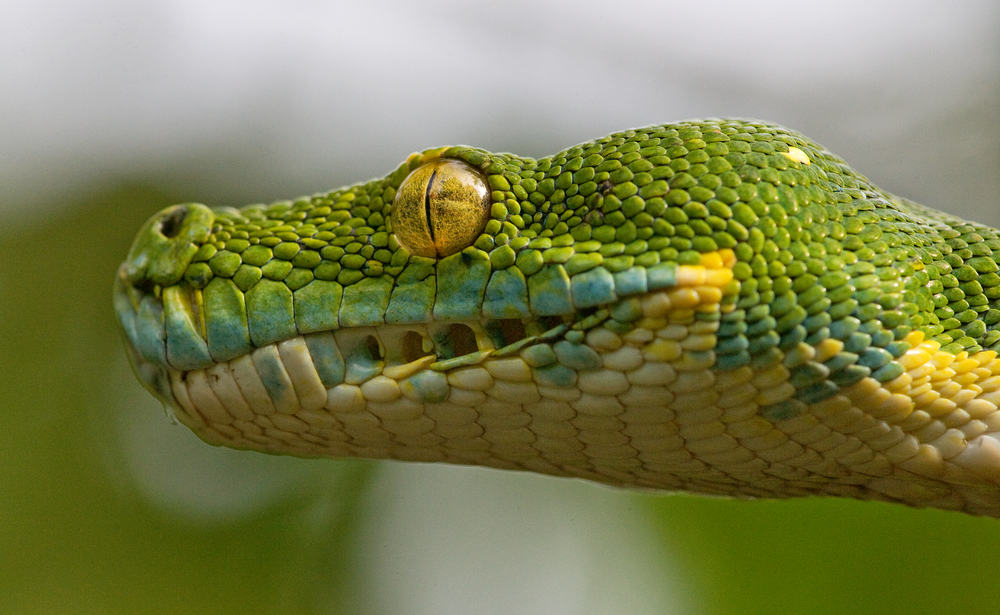
- Reproduction – Emerald tree boas are viviparous, meaning they give live birth. Green tree pythons are oviparous, meaning they lay eggs.
There’s no general consensus on which makes a better pet. They’re both species that require more advanced keeping experience.
Can Green Tree Pythons Change Color?
Green tree pythons change color from juveniles to adults. This is what’s known as ontogenetic color change.
Juveniles are born bright yellow, red, or red-brown. They change color to bright green between 6-24 months old.
There are natural color and pattern variations in green tree pythons. Some adults will stay yellow, while others turn blue.
Females will occasionally turn “hormonal blue” before ovulating.
Green tree pythons are amazing display animals for those with experience caring for more advanced species.
If you’re looking for a beginner’s python ball pythons are a perfect fit. You can find a wide variety of ball python morphs that are as unique and beautiful as a green tree python.
Not ready for a python? Corn snakes make fantastic beginner pets for aspiring snake keepers.
